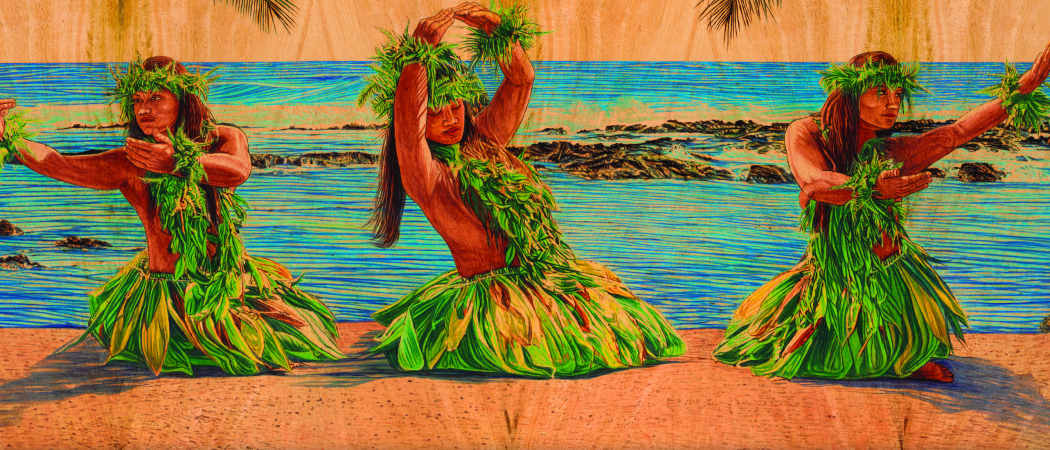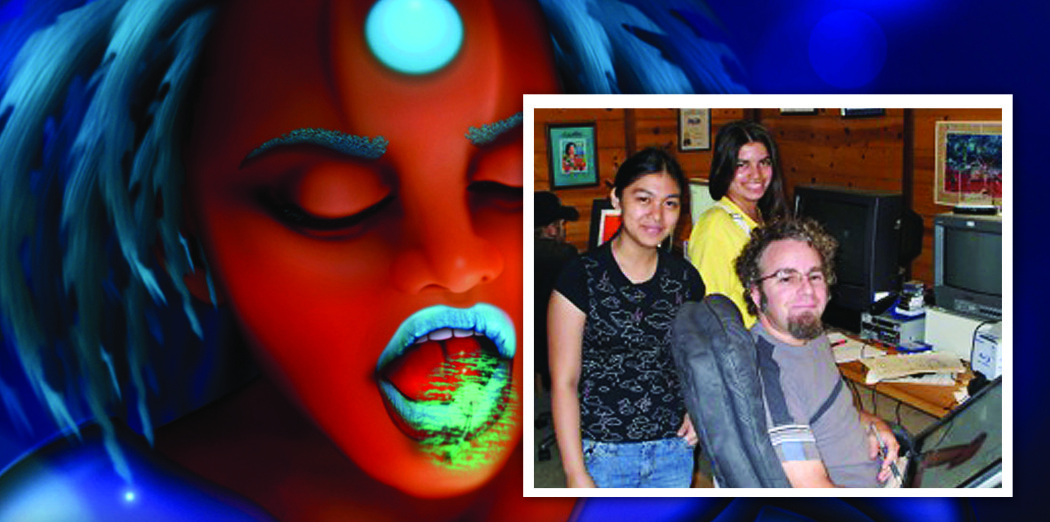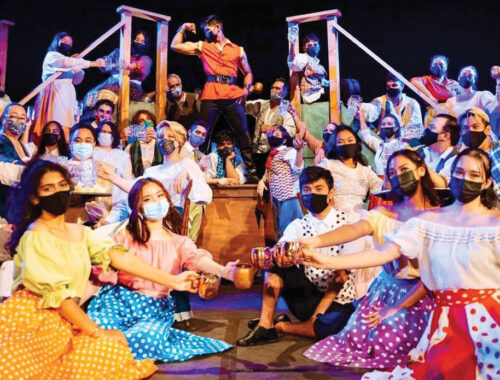
Burning Spirit: Inspirations with Master Painter David “Kawika” Gallegos
By Karen Valentine
Someone or some spirit has been looking out for David Maes “Kawika” Gallegos. With divine timing and serendipity, and in spite of personal crises, deep heartbreaks and challenges, the right person (or angel) has appeared at the right time.
The artist’s life, history has shown, isn’t an easy one. The psyche that produces the most inspirational works is sometimes the most fragile one. It’s open to attacks of genius and psychological trauma alike. Yet, in the case of Kawika, he perseveres and awaits the next one.
“My best work comes from a severe emotional response, such as a heartbreak. In between, I paint flowers,” says Gallegos. “For Picasso, it was ‘Guernica.’” For Gallegos, in spite of huge success, major commissions and acclaim for his art, his eyes reflect pathos, his face is sculpted with life’s journeys, and still his outlook remains optimistic. Life has formed him into a generous, humble and loving soul, quick to give compliments and a helping hand to others.
“All really good artists start as young men-about-town and then disappear into the woodwork,” he says, not too subtly hinting at his own past, hard-living and extravagant lifestyle — which has decelerated into a modest home studio in Puna, inhabited by the somewhat reclusive artist and his cat, Mango. The work coming out of this studio is profound, however, and the culmination of four decades of practice, more than 3,000 completed artworks—and a visit from the goddess Pele that directed his current passion for wood-burned or pyrographic oil painting on wood grain.
“I know it is cliché,” said Gallegos, “but I have had other experiences here in Hawai‘i that are similar. The spirits are here—the night marchers are real.”
His first chicken-skin story comes from 2005, eight years after moving to Hawai‘i full-time. Gallegos, who is Native American and Spanish by birth, was “beginning to be inspired in a real way by the deeply spiritual meanings of the Hawaiian culture. It started to mingle with my own Native American heritage,” he says. The beauty of the scenery impacted him so deeply it was almost painful. He had met several hula dancer models who helped him paint traditional hula. “I was painting hula because I wanted to help get rid of the Hollywood stereotypes and to capture the tradition and sacred nature of hula.” His model Kanani led him to South Point and Kaulana Bay, where they did prayer and ceremony prior to his deftly painting her movements with the foaming sea as backdrop.
The story continues when, in addition to his own work, he was helping his sculptress wife write a proposal for the Volcano Art Center Gallery’s “Wahi Kapu” project. “My ex was having a hard time writing the right sentence for her proposal. We came to the end of a paragraph she was having trouble with, and I said, ‘No, it should say: …and the Hawaiian people will be respected!’ At that exact moment, all the doors in my house slammed shut by a large wind, and I heard thunderous footsteps outside. It sounded like ten big NFL men, running through the yard, it was loud, ground-shaking. I looked outside, and there was nothing there.”
Born in Denver, Colorado, David Gallegos grew up there and in San Francisco — a child and grandchild of Arapaho and Cheyenne ancestry. (His great-grandmother married Kit Carson.) His family had “escaped” the reservations, yet the spiritual lessons and mana, as the Hawaiians would express it, were passed down.
At age 2, David had his right hand caught in a washing machine wringer, with terrible injuries, severing part of his little finger and leading to disfigurement and years of multiple surgeries to make it as functional as possible. His surgeries are in medical textbooks, he says. “When I say I’ve been through the wringer, I really mean it!” he quips.
“My first conscious memory of art, at age 4 or 5 was an enlarged, detailed photograph of the right hand of Michaelangelo’s sculpture, ‘David,’” Gallegos commented. Much later, he completed a nine-painting series for Genentech Corporation featuring exquisite representations of another master, Leonardo da Vinci’s anatomical drawings and journal entries.
After winning full-tuition scholarships in painting and drawing, Gallegos received his bachelor’s of fine arts degree with high distinction from California College of Arts and Crafts in 1974. In 1977 he received his master’s of fine arts degree in painting and printmaking from the University of California, San Francisco.
In the San Francisco Bay area from 1978 to 1990, Gallegos had numerous one-person and group museum exhibitions. During this time he worked with the famous lithographer, Ernest De Soto. From 1986 to 2006 he traveled throughout the U.S., Europe and Japan, participating in numerous museum and A-list gallery exhibitions and meeting with great success. David’s art has been featured in Architectural Digest, Art in America, Art Week, Smithsonian, Art Forum (with Ernest DeSoto) and the Encyclopedia of Important American Artists. Gallegos’ work is displayed in a number of prominent museums and galleries in major cities, including San Francisco, Palo Alto, and Santa Barbara, California; Chicago, Illinois, and Austin, Texas. Gallegos artworks hang in a great number of private and corporate collections internationally, and he is in demand for private and corporate commissions worldwide. Some of his corporate commissions were for Google, Genentech, Constellation Corp., Robert Mondavi Winery, numerous Hollywood legends and a billionaire brewery king in India, who is part of The UB Group – London, U.K.
Gallegos first landed in Hawai‘i in 1984. “I had just finished my ‘Art for Peace’ project about nuclear proliferation in the world, in which I made a large lithograph, a triptych of Chicago the day after a nuclear holocaust, and I sent posters to every member of the U.S. House and Senate. I remember receiving many letters from Congressmen and Senators, the best one from Sen. Daniel Inouye. I guess this is why one of my biggest collectors, Robert and Margrit Mondavi, suggested Hawai‘i to me. After a show I had at their winery, Robert said I would love Hawai‘i and its temperament.” He took their advice and made arrangements to visit Kona.
“I’ll never forget the plane landing on this island; when the jet door opened, the most beautiful, moist air I have ever felt, rushed through the cabin. I came down the stairs of the plane, and beautiful women were putting leis around everyone’s neck. Then I smelled the most beautiful fragrance in the world, a plumeria, and it seemed as if the whole island smelled like this beautiful flower!” On the drive into Kona, Gallegos said he was stunned by the visual beauty of the island. “Remember, I’m an artist, beauty is the only thing I see, and this was after having been a full-time professional artist for ten years with many museum and gallery shows under my belt, so everything was aglow with color to me.” Arriving at his host’s house, he says, the first thing he did was to pull out a watercolor palette and paper and immediately start painting watercolors of the setting sun and the sky. “They must have captured something; I sold them all. This series of watercolors were about 20” x 16” and some were quite beautiful, as I would experiment with the drizzle of rain on the paper and would paint the watercolors wet on wet—and fast! I painted until the sun was gone, and it became dark, and I slept like a baby.”
David received his nickname “Kawika,” from the well-known fire-dancer Kimo Lim, during that first visit to Kona, on a spontaneous trip to Kona Village with a troupe of hula dancers and drummers in the van with him. “Kimo asked me what my name was, and I said ‘David’ and he said, no, it’s ‘Kawika!’” I explained to him I was Native American, and he said to me ‘That means you hapa haole!’” We arrived at Kona Village, it was getting dark, and I was told my job was ‘up there…. You’re an artist, follow the instructions; make sure the right color is on the right people. I climbed the stairs, and there sat a large, old-fashioned, 1950s-era light filter, with gear-shift knobs.’” He was to operate the lighting for the entire show.
“The drumming started, the sun was sinking, and my first cue on the paper came up with a red light for the conch shell blower. Then, the first set of hula dancers came out. I was mesmerized; I could barely get my chicken-skin down after hearing the conch shell by the time all of these beautiful—and I mean beautiful—hula dancers came out, followed by the male dancers. Then the finale: Kimo Lim came out with a fire dance so amazing, I have never seen anyone equal it since. With the ocean breeze, crystal clear night with a zillion stars, and a big smiling moon in the sky, I was definitely in love with Hawai‘i,” exclaims Kawika with passion, even today, decades later.
This night turned into a local job for Kawika, running the lights at Kona Village, which lasted four months, until he had to return to the mainland. But it set the tone for his love affair with Hawai‘i. “I’ll never forget Kimo,” he says, “because as a stranger to the island, and as an artist, to have this brilliant fire dancer, twice my size, be so kind to me would always stay with me.
And then a few years later, Kimo died in a helicopter crash, in a ball of fire.”
Gallegos’ style is super-realism, painting in detail that is more precise than photographic, because there is nothing out of focus. In art school, he says, “Painting was dead,” and everyone was experimenting with other, very outrageous forms of art. He credits pop artist Andy Warhol for a return to realism, even though it featured the banal and the consumerist culture. “It took a lot of chutzpah to get through art school,” he says, for a realist taught by some of the best realists in the business “to paint every square inch in as much detail as every other one.”
The Japanese loved his style, and he was “snatched away” by a Japanese art publishing company for five years from 1990 to 1995 to paint 400 scenic paintings that would be turned into color fine art serigraphs. He says he signed 18,000 prints. Even though it was a lucrative contract for Gallegos, he said, the company made profits a thousand times bigger from his work. At the end of that “servitude,” he moved to Hawai‘i. During previous visits, he had already begun researching galleries that might show his work, which began selling right away.
In Hawai‘i, the realism practiced by Gallegos needed another layer. Underneath reality, there is a hidden world of spirit, and he wanted to express that as it had been awakening in him since he first felt it in Hawai‘i.
“Hawaiian spirituality is equal to the beauty of their ‘āina,” he says. “It’s the same with American Indians, who share the same tragedy as the Hawaiians and maintain that same spirit. Hawaiian spirit is pure beauty. It is the spirit of nature first, and that points to everything. Kīakahi means that everything has a purpose. Fish swim because they swim. Birds fly because they fly. It is the same with the Native American tribes. All living things are our brothers and sisters. Trees are standing people, rocks are stone people, winged ones, finned ones, creepy crawlers, all of them. Artists create because they create. I try and live in my artwork, as I live in my spirituality and honor the ‘āina where it is that I live.”
Kawika found that deeper reflection of spirit in the woodgrain that he has chosen as his canvas. A burl, a swirl of grain, a pattern, a hue of natural color become not only the basis for the oil paintings, they become part of the image. Koa creates an ideal background for luminous moonscapes, mango may offer up rays of the sun, ‘ohia and other woods all express their unique spirit images. When you view a kumu hula in a progression of hula movements, the images in the grain above her head appear as kūpuna, or teacher-ancestors, looking down upon the scene with approval.
Gallegos began using paper-thin veneers, cross sections of the tree, but not enough to sacrifice major portions of trees.
Shortly after he had started working with woodgrains, he was driving from Waimea, turning onto the Saddle Road, on his way home from a gallery opening at Harbor Gallery in Kawaihae. “I started up the Saddle Road, which was at first clear, and then it turned into a very thick and rainy fog — the road is so alone up there, about 10 to 15 miles up from the upper belt road — and I could not see but ten feet away. What first came into view through the thick fog was a woman — all I saw was her standing alone. I had already been held up by a car accident near Waimea, and I thought there might have been another one, which is why I pulled over. It was late, around 11 p.m. I stopped, and the woman seemed to float into the back seat, I would remember later. I felt something jump in with her. I was so tired, but it felt like a dog or something leapt in with her. I could not really see if she was young or old, I just knew it was a woman who needed help up there, late at night. I asked if everything was OK, and there was just a silence. My mind just accepted the fact that this person needed a ride, and the driving was no joke, so I was concentrating. I did not even look in the rear view mirror; it was very dark, so I kind of looked, but could not see anything. I heard a dog, I thought about medium size, moving around. Finally, I asked where she needed to go. That is where I felt something. A stick or pole of some kind just kind of bumped the top of the right hand car seat, pointing straight ahead, I felt the hair go up along the back of my head. And it was then I felt a different vibration than just a woman in need of a ride. Finally, as the road started to swing down into Hilo, the rain and fog stopped, and I turned around and said, ‘Where in Hilo…do…you..want..to…’ and the woman and the dog were gone. There was no one, nothing in the back seat of my car. The hair went back up my head again. It was like an electromagnetic energy. I hightailed it home. I know not why this woman came and went. I was told it was Pele, and that it was a blessing for me, but it scared me with its power,” says Kawika. “I feel that she was saying things were okay with me and my work, and that it was about love, not anger.”
The visitation happened during a period when Kawika was experiencing a lot of inner angst himself, as well as self-doubt. He had been saying to himself, “Nobody will like me; nobody will listen to me.” He decided, “I’m going to burn every line in. I feel I was also tapping into the Polynesian tradition of tattoo. Every line is burned very deep.” It was a determination to make something permanent, more profound, to make a statement that could not be erased. He burns in the outlines and the detail lines of each painting onto the wood veneer before adding the color. And the colors, too, are laid on with the same kind of determination that it become indelible. Like Leonardo Da Vinci’s ‘Mona Lisa,’ which is painted in sfumato style, with perhaps 1,000 glazes, Gallegos lays on layer after layer of tinted oil glazes, giving his paintings a luminescent depth that makes the images glow, especially when rendering a fisherman’s torch in the moonlight. He chooses the placement of objects on the woodgrain to integrate the image with the grain so they complement each other. After burning in the image, he fills in the lines with paint and adds around 70 layers of glazes.
Gallegos says in his artist’s statement: “Art is a journey of the soul.”
He elaborates, “As an artist, I pick up the spirit of the ‘āina and the ‘āina and spirit come through me to give back.”
As his Cheyenne grandfather would say, “You walk the Good Red Road.”
“I never wasted a single day with the gift Creator gave me to create.”
When asked what advice he offers to young artists, Kawika says, “Study all the master artists. Get your bachelor and master of fine arts degrees. This is very important later in an artist’s life, as the auction houses: Sotheby’s, Bonham and Butterfields, Sloan and Kenyon, look for these degrees. As such, my artworks from the 1980s and ‘90s are selling at the above auction houses today. Work, work, work and show, show, show! Don’t be shy and glide over criticism. Criticism for artists is like calluses on a guitarist’s hands. The more one plays, the thicker the calluses. You become invulnerable over time.
David “Kawika” Gallegos is represented on Hawai‘i Island by Harbor Gallery in Kawaihae. His work may also be found at Eclectic Craftsman in Kailua-Kona, and at Ke‘ei Café in Kainaliu. ❖
Contact writer Karen Valentine.
Art images courtesy of the artist. Website: KawikaSpiritArtStudio.com


